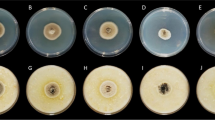Summary
The taxonomy of edible Colocasia (Cocoyam) is confusing. The existence of one species, C. esculenta var. antiquorum or C. esculenta and C. antiquorum as two separate species is controversial. Nine high yielding Nigerian cultivars of cocoyam made up of members of the two taxa were grown under the same environmental conditions. As a preliminary investigation, 17 characters were monitored and recorded to help in the classification of the cultivars. Results showed that cocoyams can be grouped into two separate species. The qualities possessed by TCe 23, Nwine and Ukpon cultivars which include pink tuber skin, long or club shaped cormels and non-irritation in the throat when boiled and eaten, clearly distinguished them from those of Tce 15, 19, 27, 36, Ede-ofe and Kochuom.
Similar content being viewed by others
References
Bailey, L. M., 1925. Manual of cultivated plants. MacMillan, London. pp. 135–136.
Barrau, J., 1957. Les Aracées du tubercules alimentaires des Iles du Pacifique. Sud. J. Agric. Trop. Bot Appl. 4: 34–52.
Coursey, D. G., 1968. The edible aroids. World Crops 20: 25–30.
Hagnauer, R., 1959. Taxonomic value of cyanogenesis in higher plants. Paper presented at the IX International Botanical Congress, Montreal. In: Recent Advances in Biology, Vol. 1. University of Toronto Press. 947 pp.
Haudricourt, A., 1941. Les Colocasiées alimentaires (taros et yautias). Rev. Bot. Appl. Agric. Trop. 21: 40–65.
Hill, A. F., 1939. The nomenclature of the taro and its varieties. Bot. Mus. Leafl. Harv. Univ. 9: 113–118.
Hodge, W. H., 1954. Flora of Dominica, B. W. I, part 1. Lloydia 17: 155–160.
Ikediobi, C. O. & L. C. Igboanusi, 1983. Identification of yam (Dioscorea spp.) species and cultivars by use of electrophoretic patterns of soluble tuber proteins. Biotropica 15 (1): 65–67.
Jonker-Verhoef, A. M. E. & F. P. Jonker, 1959. Notes on the Araceae of Suriname. II. Acta Botanica Neerlandica 8: 139–155.
Onwueme, I. C., 1978. The tropical tuber crops. John Wiley and Sons, New York, 234 pp.
Onyilagha, J. C. & J. Lowe, 1986. Studies on the relationship of Dioscorea cayenensis and Dioscorea rotundata cultivars. Euphytica 35: 733–739.
Purseglove, J. W., 1972. Tropical crops. Monocotyledons I and II. The English Language book Society and Longman. 607 pp.
Rogers, D. J. A., 1967. Computer aided morphological classification of Manihot esculenta Crantz. Proc. Int. Symp. on Trop. Root Crops. Trinidad, Section I, pp. 57–80.
Sivan, Pl., 1973. Effects of spacing in taro (Colocasia esculenta). 3rd Int. Symp. Trop. Root Crops, Ibadan, Nigeria.
Sneath, P. H. A. & R. R. Sokal, 1973. Numerical taxonomy. Freeman, W. H. & Company, San. Francisco, 573 pp.
Sokal, R. R. & P. H. A. Sneath, 1963. Principles of numerical taxonomy. Freeman, W. H. & Company, San Franciso. 359 pp.
Author information
Authors and Affiliations
Rights and permissions
About this article
Cite this article
Onyilagha, J.C., Omenyi, A.S., Illoh, H.C. et al. Colocasia esculenta (L.) Schott, Colocasia antiquorum Schott, how many species? 1. A preliminary investigation. Euphytica 36, 687–692 (1987). https://doi.org/10.1007/BF00041519
Received:
Issue Date:
DOI: https://doi.org/10.1007/BF00041519




